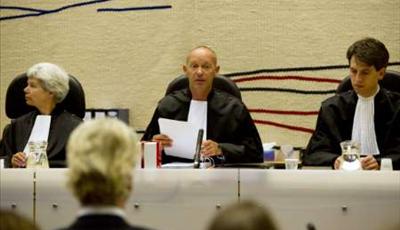|
More on the Wilders trial
Over at Gates of Vienna, there is detailed coverage of the testimony yesterday by the “aggrieved parties” in the Wilders trial (which, according to Serge Trifkovic writing at Chronicles, ended last week). It seems that the witnesses went beyond telling how Wilders’s critical statements about Islam had caused them harm, and were improperly allowed by the court to argue that Wilders should be found guilty. Check out the photos of the judges, one of whom is a Negro or Moor, and another a long haired hippie with gray hair. With their bizarre and (to my eye) menacing uniforms, they look like characters in a bad sci-fi film. What a country! Here’s another photo of the trial, from Diana West’s site, with Wilders seen from behind facing the judges, though these are different judges than in the photos at GoV:

Herman B. writes:
The pictures at GoV don’t show the judges at all, these are the complainants.LA replies:
Thanks for this. Maybe this is some ancient and honored Dutch tradition, but to a stranger, it certainly seems odd, that witnesses would wear the same robes as the judges. A judge’s robes symbolize the idea that he is carrying out an impersonal, “higher” function as a representative of justice and the state. But a witness or complainant in a trial is merely representing himself, telling the facts as he knows them. He does not represent anything beyond himself. So why would the Dutch courts require witnesses to wear robes? What is being conveyed by that? And if the complainants wear robes, why not the defendant? This again seems to be an expression of the inquisitorial nature of Dutch and European courts: the witnesses for the prosecution have an official, sacred character which the defendant does not have. The defendant just represents himself. The complainants represent … the state.Herman B. writes:
When I said the black (Muslim) guy and the grey haired hippie in the GoV pictures were the complainants I wasn’t clear enough. They were the lawyers for the complainants.Snouck writes:
The pictures at GoV do not show complainants but the lawyers who represent them. Plaintiffs and defendants are not required to wear special clothing in Dutch courts. Posted by Lawrence Auster at October 19, 2010 09:56 AM | Send Email entry |